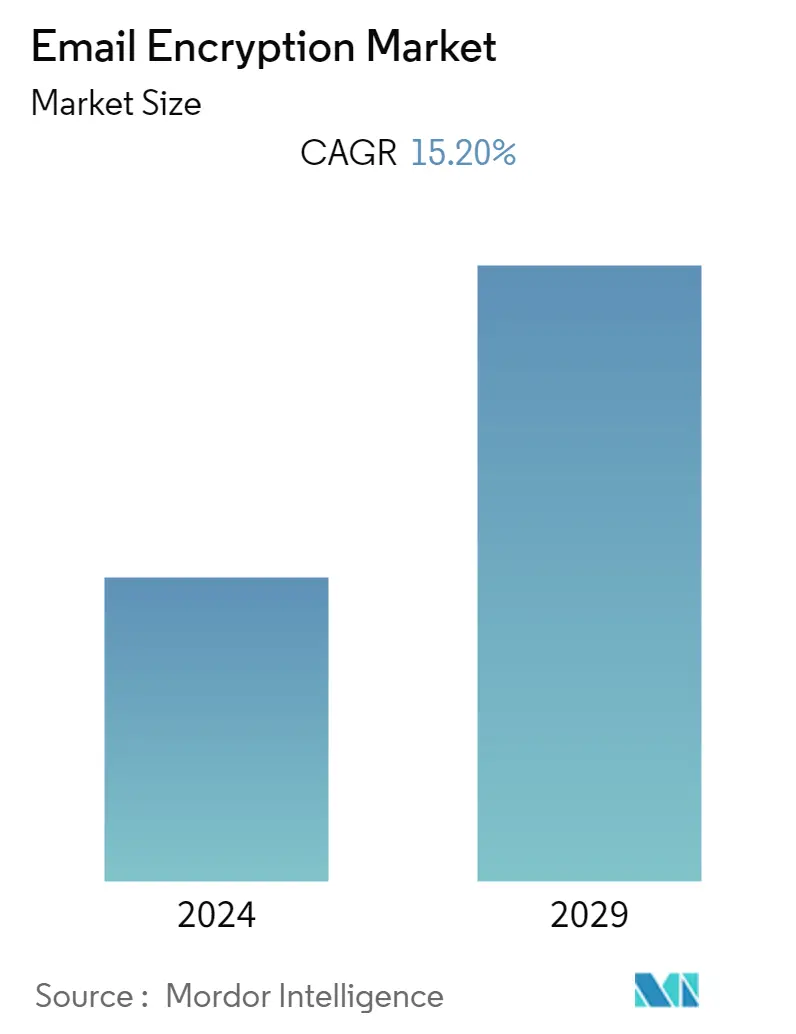Market Size of Email Encryption Industry

| Study Period | 2019 - 2029 |
| Base Year For Estimation | 2023 |
| CAGR | 15.20 % |
| Fastest Growing Market | Asia Pacific |
| Largest Market | North America |
| Market Concentration | Medium |
Major Players
*Disclaimer: Major Players sorted in no particular order |
Need a report that reflects how COVID-19 has impacted this market and its growth?
Email Encryption Market Analysis
The email encryption market is projected to grow at 15.2% CAGR during the forecast period of 2021-2026. The technology penetration among small and medium enterprises has increased the use of email for sharing information amongst its clients and employees. These business emails often carry confidential data which is required to be protected from theft and manipulation. Email encryption is a crucial tool that helps businesses to safeguard their information from malicious programmers or scammers.
- According to Right Inbox, there were more than 3 billion email users worldwide in 2019, and that number is expected to reach 4.3 billion by 2022. Users sent an estimated more than 280 billion personal and professional emails per day in 2018. Thus, because of its widespread use, email remains a massive cybersecurity threat, with an estimated 92% of malware being delivered by email, and 56% of IT experts pointing to phishing as the top security threat.
- Among all the organizations that encountered an email-based impersonation attack in 2018, 73% experienced a direct loss (data, financial, or loss of customers). Among these events, 39% cited data, 29% financial, and 28% noted lost customers. Moreover, 38% of those who suffered losses because of email-based impersonation attacks noted data loss as the thing that severely impacted their organization.
- Additionally, most cyberattacks begin with a simple email. More than 90% of successful hacks and data breaches stem from phishing, emails crafted to lure their recipients into clicking a link, opening a document, or forward information, reported the Herjavec Group, a cybersecurity product, and services provider.
- According to Proofpoint's 'Cost of Insider Threats 2020 Global Report,' the larger the organization, the more insider threat incidents. Large enterprises with a headcount of more than 75,000 spent an average of USD 17.92 million over the past year. The smaller enterprises with a headcount below 500 spent an average of USD 7.68 million.
- Moreover, according to Cisco Systems, 70% of public and private companies will be using cloud email services by 2021. This access to email from anywhere and on any device states that it is essential that organizations protect themselves from increasingly prevalent threats.
- At the time of the COVID-19 pandemic, remote working conditions brought new security risks and productivity challenges. Cybercriminals are taking advantage of distracted employee email behavior and web browsing behavior. Remote employees are receiving an increasing volume of COVID-19-themed emails that impersonate organizations like the World Health Organization (WHO) and the Centers for Disease Control and Prevention (CDC).
- Major technology providers are taking initiatives to protect users from COVID-19 related online scams. For instance, in April 2020, Google had launched a new website focused on COVID-19 associated online security risks. Also, Google's new generation of document malware scanners relies on deep learning technologies to improve its detection capabilities across over 300 billion attachments. They scan for malware every week. These capabilities helped Google to maintain a near to 63% detection of the malicious threats blocked by Gmail.
